Abstract
Mice were subcutaneously inoculated with small numbers of virulent Cryptococcus neoformans and divided into groups. Numbers of viable yeasts at the site were estimated at weekly intervals for 5 weeks on the basis of cultures of minced tissue excised from sacrificed animals. Organisms multiplied at the site for at least 4 weeks and were still detectable after the 5th week, although in reduced numbers. Agglutinins appeared within a week, but these antibodies were not detectable during the 2nd through the 5th week. Cryptococcal polysaccharide began to appear in the sera at 3 weeks, persisting through the duration of 5 weeks. All animals appeared healthy, but a few sickened after many months and died of systemic cryptococcosis. All of these events were observed in many separate experiments. The immunizing capacity of a cutaneous lesion was tested by challenging some of the above animals with viable C. neoformans after various intervals of time, either subcutaneously at a site distant from that of the vaccination or intravenously. Although we were unable to demonstrate reduced multiplication of yeasts in the brains, lungs, and spleens of intravenously challenged animals, it was possible to show that multiplication was inhibited at the site of subcutaneous challenge. It was noted also that vaccinated animals lived longer after lethal intravenous challenge than did nonvaccinated animals. The latter protection was observed, however, only when challenge followed vaccination by 3 weeks or longer, and it was effective only against a relatively low challenge dose. Mice were protected against a higher dose if they had previously received killed cryptococci, alternating subcutaneous and intraperitoneal inoculations, one of which contained a microbial adjuvant. No protection was observed in animals that were subcutaneously vaccinated with inert materials such as chitin, latex spheres, or even cryptococcal cell walls themselves.
Full text
PDF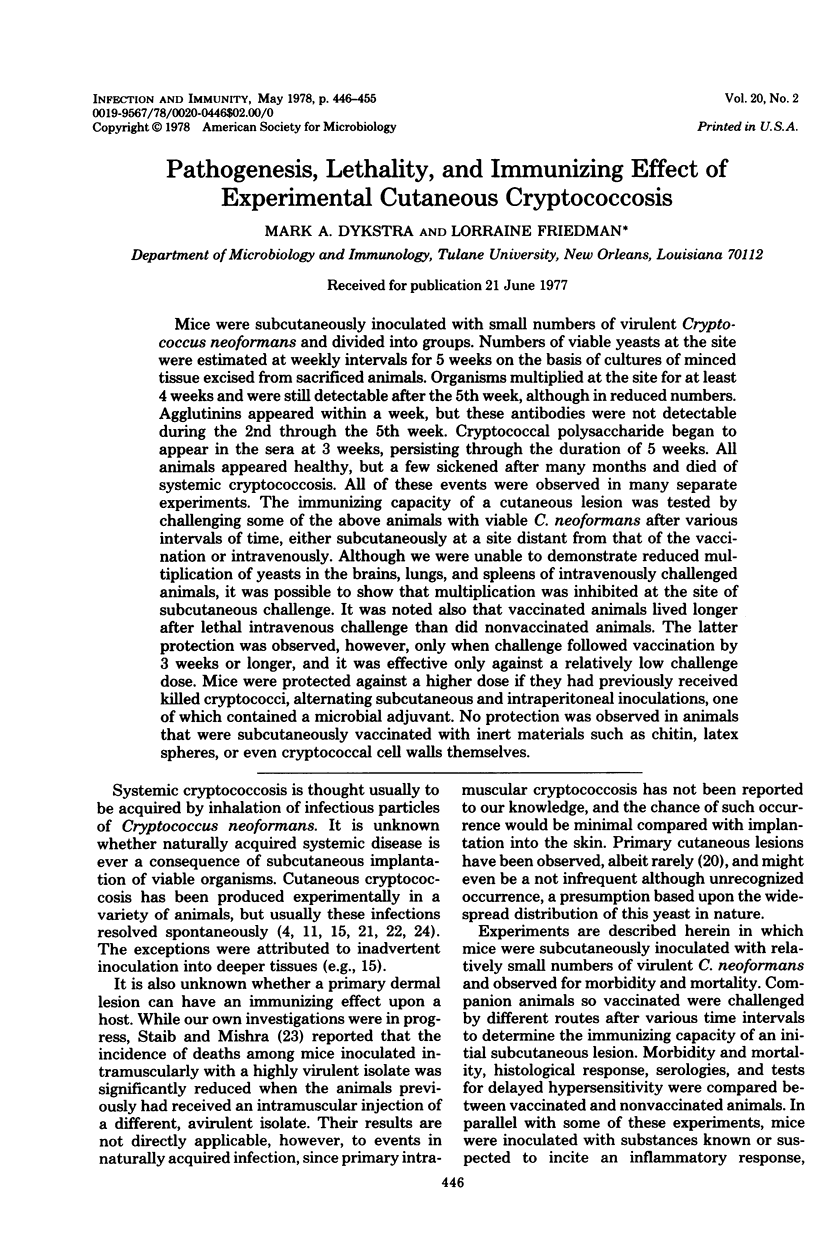
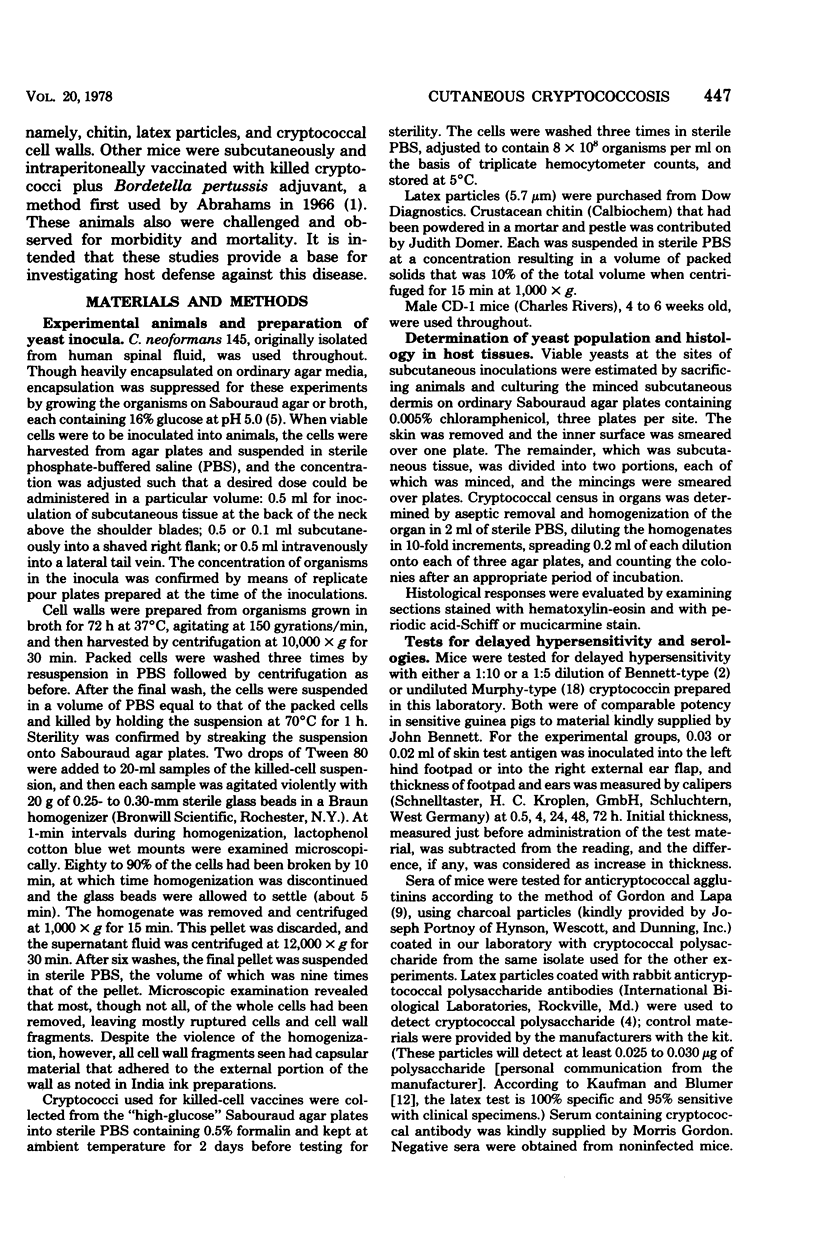
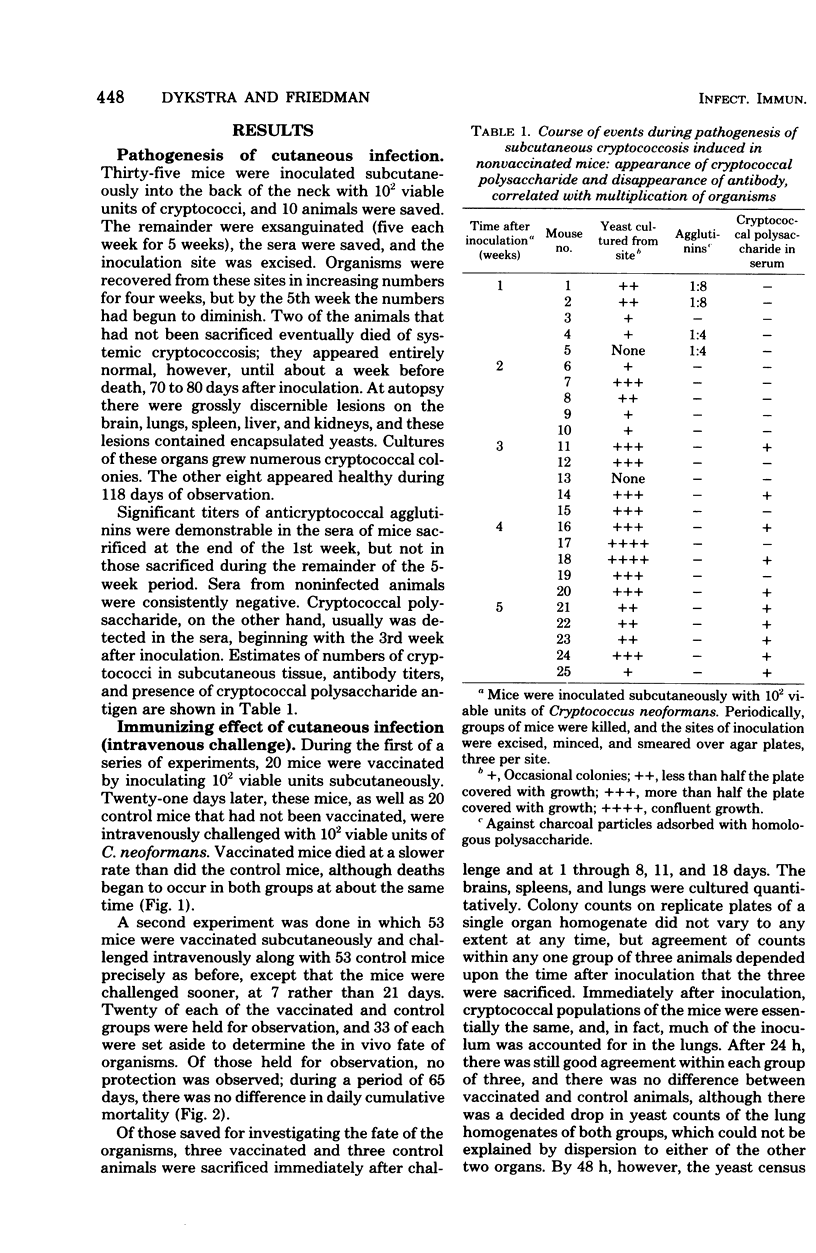
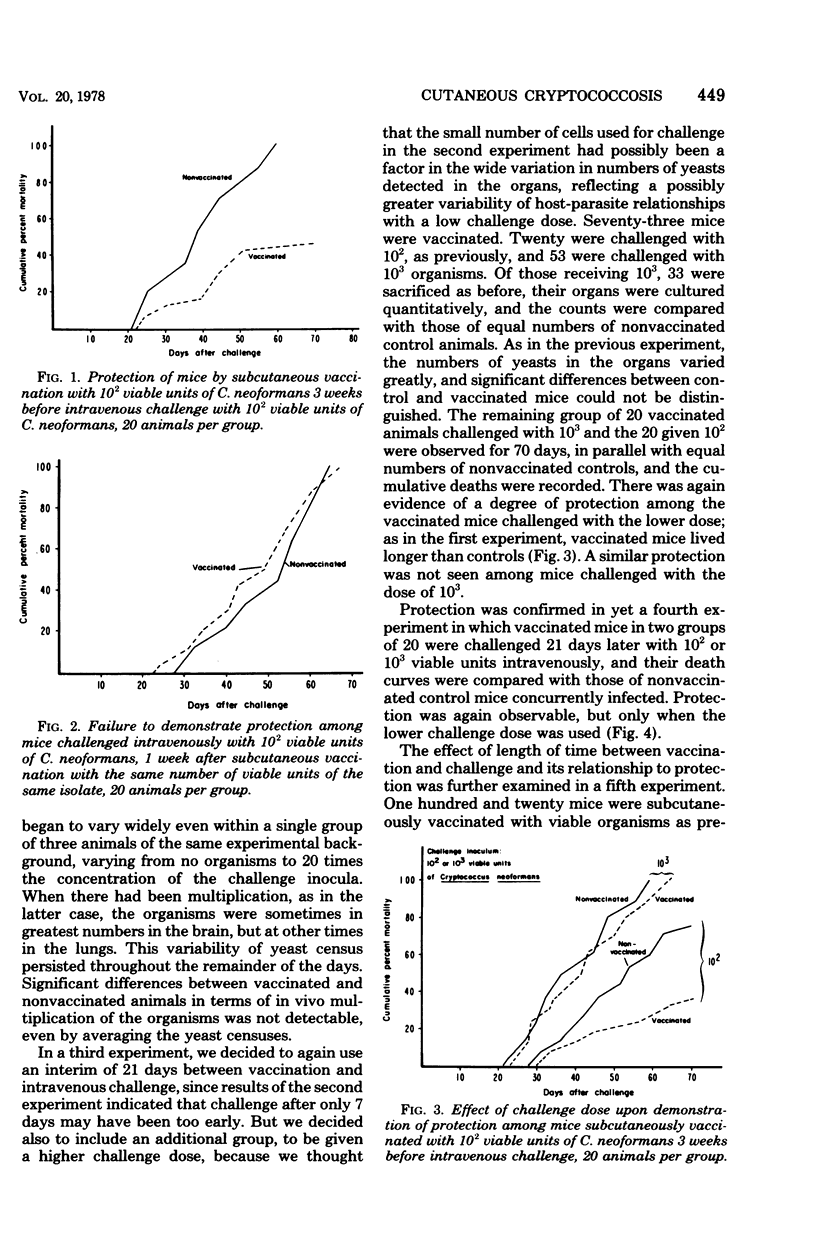
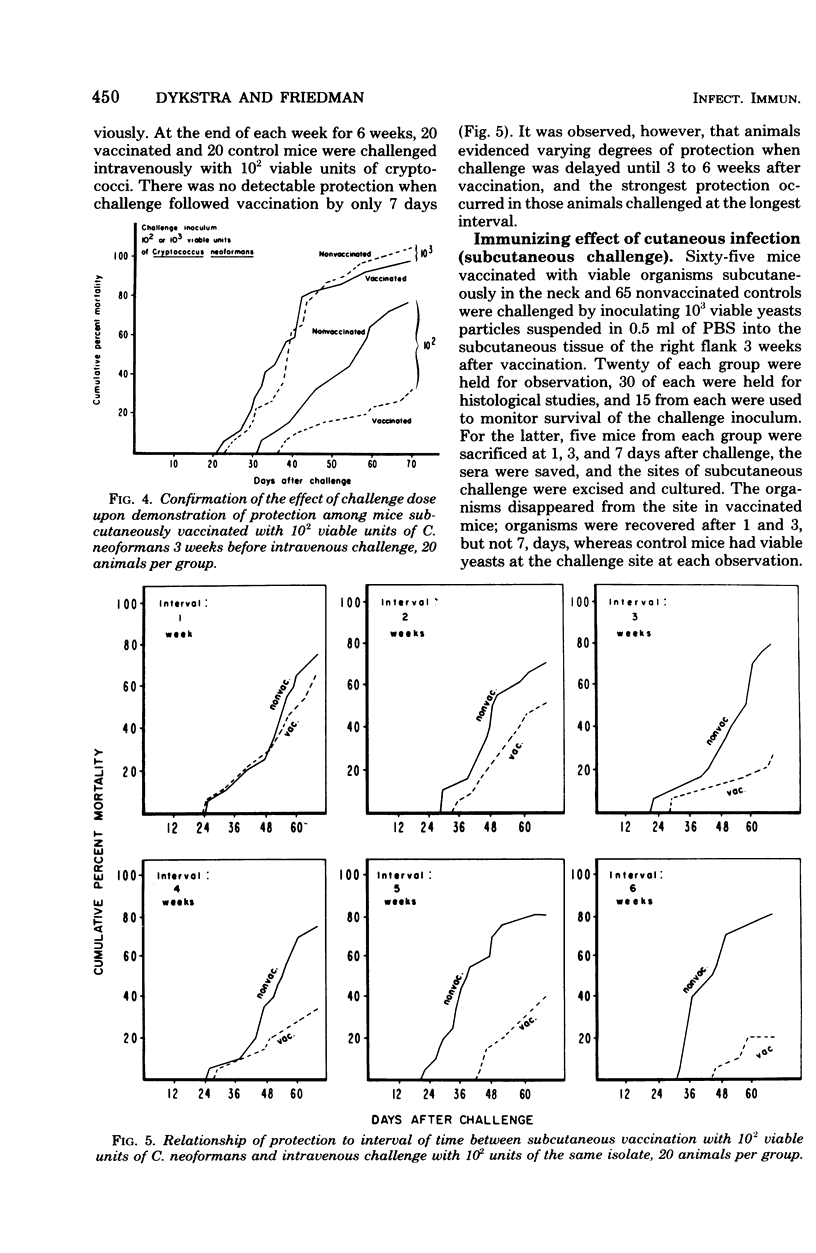
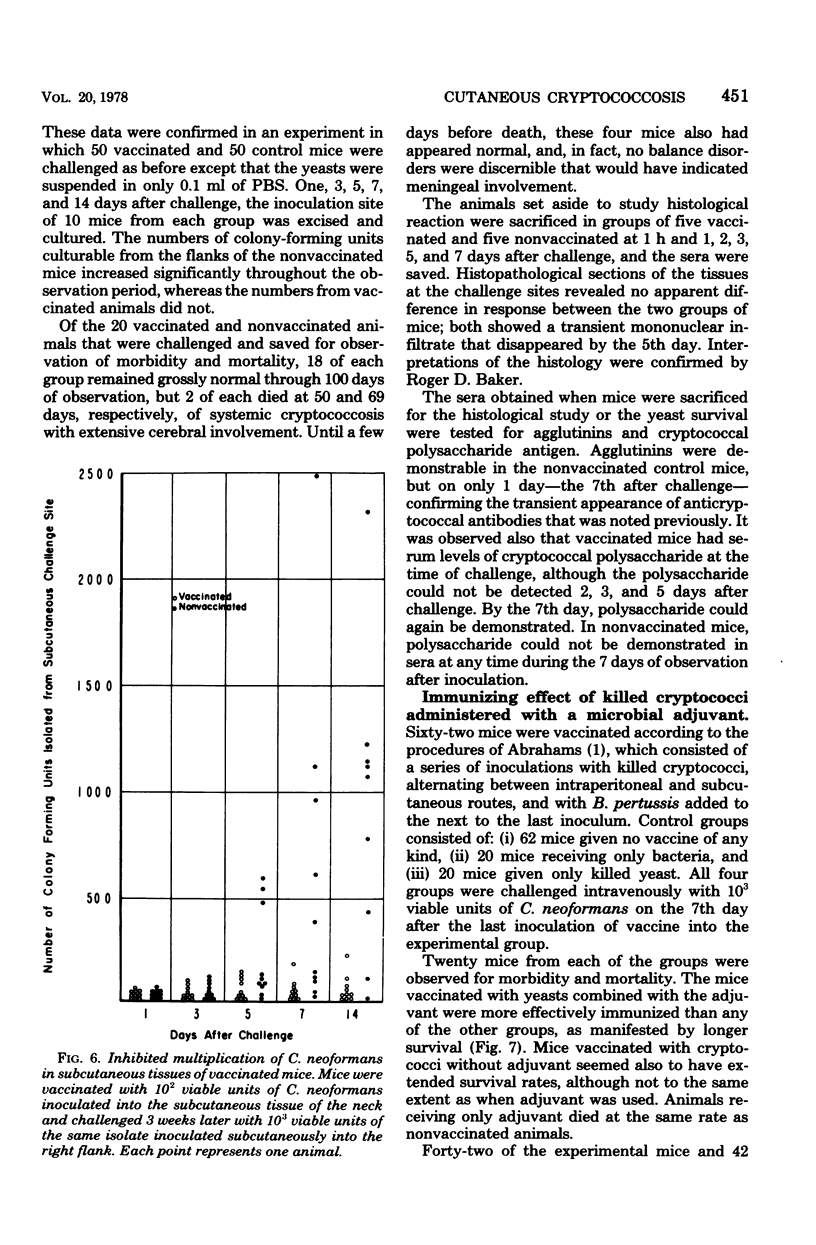
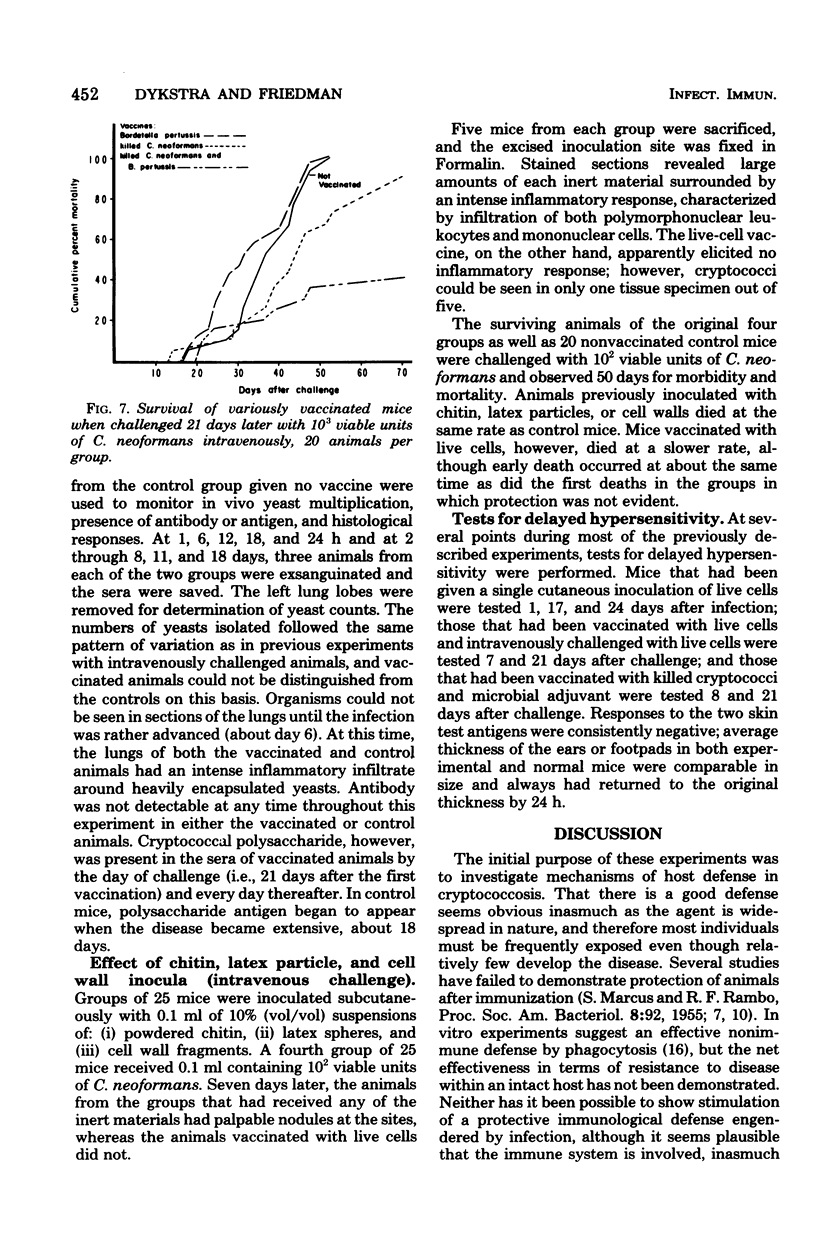
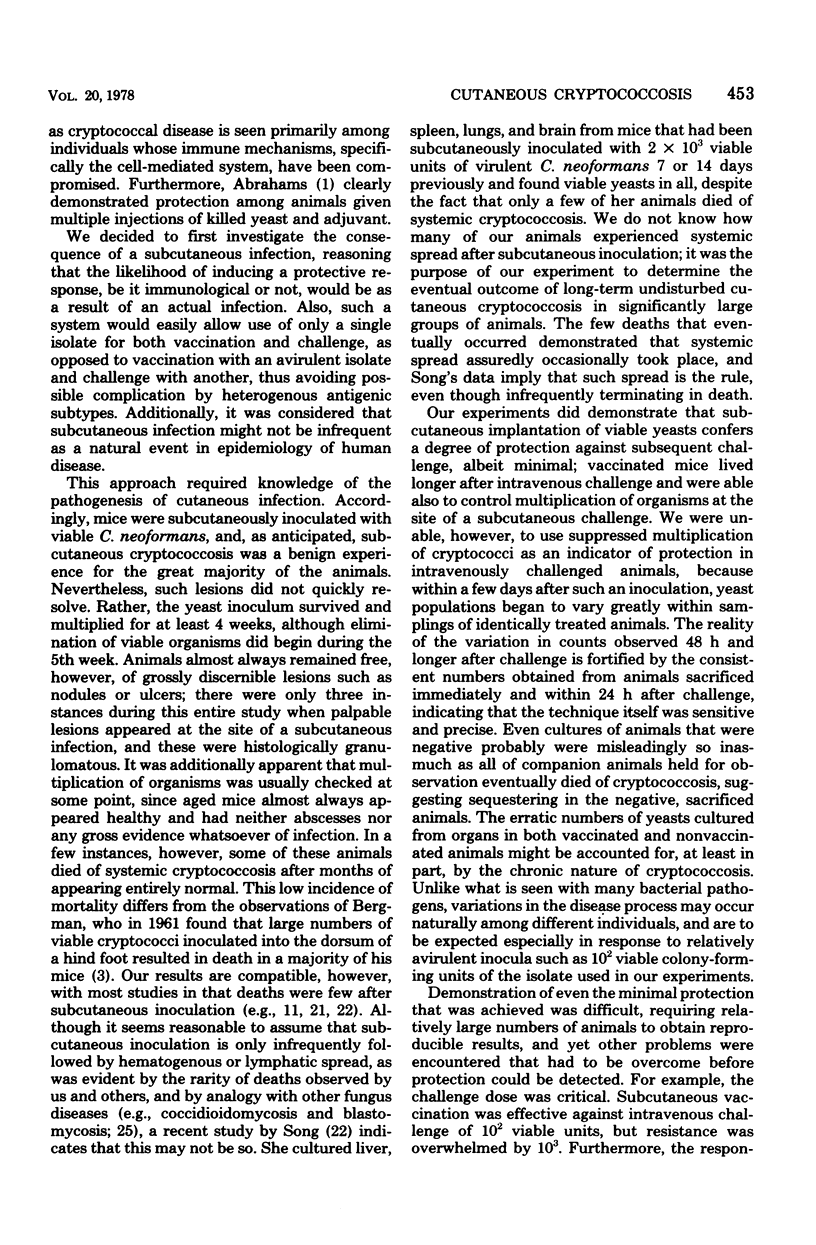
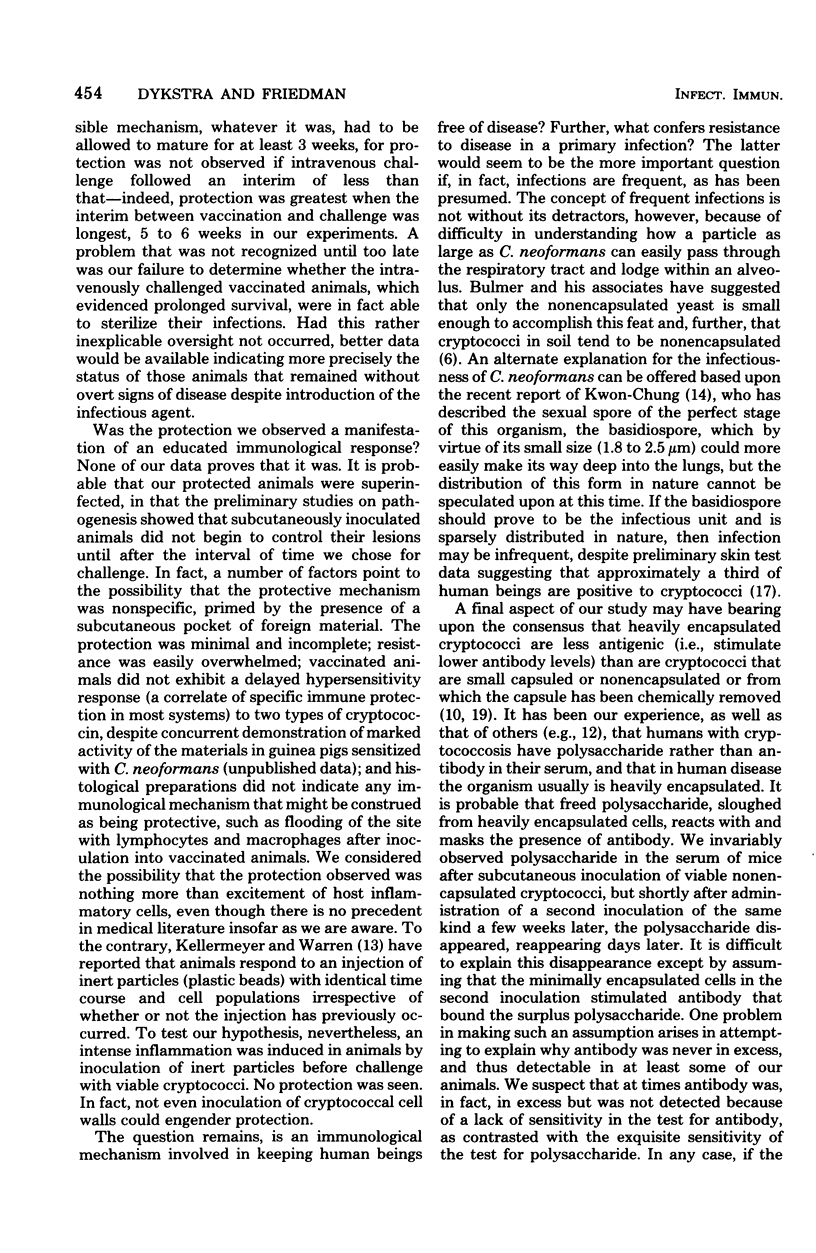
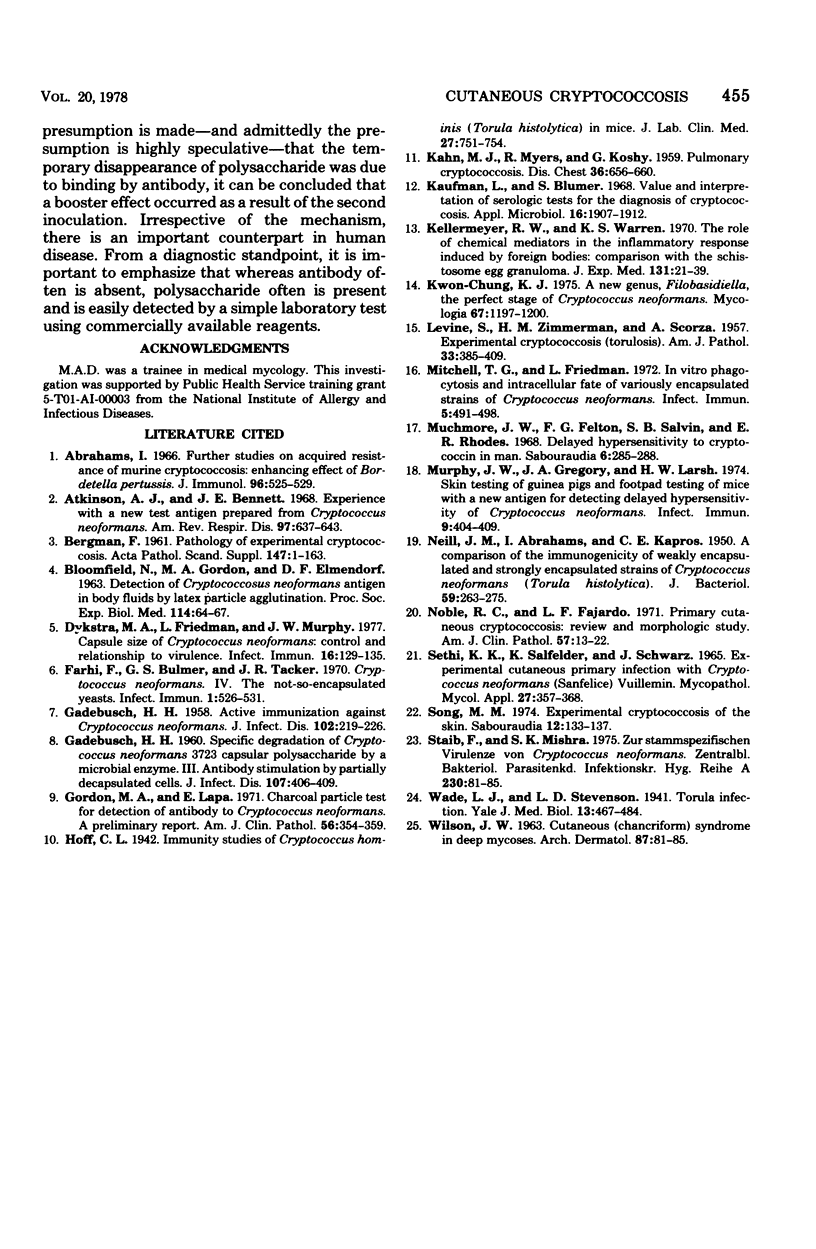
Selected References
These references are in PubMed. This may not be the complete list of references from this article.
- Abrahams I. Further studies on acquired resistance to murine cryptococcosis: enhancing effect of Bordetella pertussis. J Immunol. 1966 Mar;96(3):525–529. [PubMed] [Google Scholar]
- Atkinson A. J., Jr, Bennett J. E. Experience with a new skin test antigen prepared from Cryptococcus neoformans. Am Rev Respir Dis. 1968 Apr;97(4):637–643. doi: 10.1164/arrd.1968.97.4.637. [DOI] [PubMed] [Google Scholar]
- BLOOMFIELD N., GORDON M. A., ELMENDORF D. F., Jr DETECTION OF CRYPTOCOCCUS NEOFORMANS ANTIGEN IN BODY FLUIDS BY LATEX PARTICLE AGGLUTINATION. Proc Soc Exp Biol Med. 1963 Oct;114:64–67. doi: 10.3181/00379727-114-28586. [DOI] [PubMed] [Google Scholar]
- Dykstra M. A., Friedman L., Murphy J. W. Capsule size of Cryptococcus neoformans: control and relationship to virulence. Infect Immun. 1977 Apr;16(1):129–135. doi: 10.1128/iai.16.1.129-135.1977. [DOI] [PMC free article] [PubMed] [Google Scholar]
- Farhi F., Bulmer G. S., Tacker J. R. Cryptococcus neoformans IV. The Not-So-Encapsulated Yeast. Infect Immun. 1970 Jun;1(6):526–531. doi: 10.1128/iai.1.6.526-531.1970. [DOI] [PMC free article] [PubMed] [Google Scholar]
- GADEBUSCH H. H. Active immunization against Cryptococcus neoformans. J Infect Dis. 1958 May-Jun;102(3):219–226. doi: 10.1093/infdis/102.3.219. [DOI] [PubMed] [Google Scholar]
- GADEBUSCH H. H. Specific degradation of Cryptococcus neoformans 3723 capsular polysaccharide by a microbial enzyme. III. Antibody stimulation by partially decapsulated cells. J Infect Dis. 1960 Nov-Dec;107:406–409. doi: 10.1093/infdis/107.3.406. [DOI] [PubMed] [Google Scholar]
- Gordon M. A., Lapa E. Charcoal particle agglutination test for detection of antibody to Cryptococcus neoformans: a preliminary report. Am J Clin Pathol. 1971 Sep;56(3):354–359. doi: 10.1093/ajcp/56.3.354. [DOI] [PubMed] [Google Scholar]
- KHAN M. J., MYERS R., KOSHY G. Pulmonary cryptococcosis: a case report and experimental study. Dis Chest. 1959 Dec;36:656–660. [PubMed] [Google Scholar]
- Kaufman L., Blumer S. Value and interpretation of serological tests for the diagnosis of cryptococcosis. Appl Microbiol. 1968 Dec;16(12):1907–1912. doi: 10.1128/am.16.12.1907-1912.1968. [DOI] [PMC free article] [PubMed] [Google Scholar]
- Kellermeyer R. W., Warren K. S. The role of chemical mediators in the inflammatory response induced by foreign bodies: comparison with the schistosome egg granuloma. J Exp Med. 1970 Jan 1;131(1):21–39. doi: 10.1084/jem.131.1.21. [DOI] [PMC free article] [PubMed] [Google Scholar]
- Kwon-Chung K. J. A new genus, filobasidiella, the perfect state of Cryptococcus neoformans. Mycologia. 1975 Nov-Dec;67(6):1197–1200. [PubMed] [Google Scholar]
- LEVINE S., ZIMMERMAN H. M., SCORZA A. Experimental cryptococcosis (torulosis). Am J Pathol. 1957 May-Jun;33(3):385–409. [PMC free article] [PubMed] [Google Scholar]
- Mitchell T. G., Friedman L. In vitro phagocytosis and intracellular fate of variously encapsulated strains of Cryptococcus neoformans. Infect Immun. 1972 Apr;5(4):491–498. doi: 10.1128/iai.5.4.491-498.1972. [DOI] [PMC free article] [PubMed] [Google Scholar]
- Muchmore H. G., Felton F. G., Salvin S. B., Rhoades E. R. Delayed hypersensitivity to cryptococcin in man. Sabouraudia. 1968 Oct;6(4):285–288. doi: 10.1080/00362176885190561. [DOI] [PubMed] [Google Scholar]
- Murphy J. W., Gregory J. A., Larsh H. W. Skin testing of guinea pigs and footpad testing of mice with a new antigen for detecting delayed hypersensitivity to Cryptococcus neoformans. Infect Immun. 1974 Feb;9(2):404–409. doi: 10.1128/iai.9.2.404-409.1974. [DOI] [PMC free article] [PubMed] [Google Scholar]
- NEILL J. M., ABRAHAMS I., KAPROS C. E. A comparison of the immunogenicity of weakly encapsulated and of strongly encapsulated strains of Cryptococcus neoformans (Torula histolytica). J Bacteriol. 1950 Feb;59(2):263–275. doi: 10.1128/jb.59.2.263-275.1950. [DOI] [PMC free article] [PubMed] [Google Scholar]
- Noble R. C., Fajardo L. F. Primary cutaneous cryptococcosis: review and morphologic study. Am J Clin Pathol. 1972 Jan;57(1):13–22. doi: 10.1093/ajcp/57.1.13. [DOI] [PubMed] [Google Scholar]
- Sethi K. K., Salfelder K., Schwarz J. Experimental cutaneous primary infection with Cryptococcus neoformans (Sanfelice) Vuillemin. Mycopathol Mycol Appl. 1965 Dec 1;27(3):357–368. doi: 10.1007/BF02053794. [DOI] [PubMed] [Google Scholar]
- Song M. M. Experimental cryptococcosis of the skin. Sabouraudia. 1974 Jul;12(2):133–137. doi: 10.1080/00362177485380191. [DOI] [PubMed] [Google Scholar]
- Staib F., Mishra S. K. Zur stammspezifischen Virulenz von Cryptococcus neoformans Tierexperimentelle Beobachtungen über zwei C. neoformans-Stämme aus Vogelfäkalien. Vorläufige Mitteilung. Zentralbl Bakteriol Orig A. 1975 Jan;230(1):81–85. [PubMed] [Google Scholar]
- WILSON J. W. Cutaneous (chancriform) syndrome in deep mycoses. Arch Dermatol. 1963 Jan;87:81–85. doi: 10.1001/archderm.1963.01590130087013. [DOI] [PubMed] [Google Scholar]


